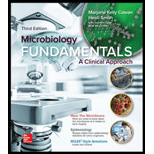
Microbiology Fundamentals: A Clinical Approach
3rd Edition
ISBN: 9781259709227
Author: Marjorie Kelly Cowan Professor, Heidi Smith
Publisher: McGraw-Hill Education
expand_more
expand_more
format_list_bulleted
Question
Chapter 18.3, Problem 1MM
Summary Introduction
To determine:
The blood-borne virus that can be transmitted by needle sticks for which health care workers are vaccinated
Introduction:
The infections that are gained in the “hospital or related facilities” are termed as “nosocomial” or “hospital-acquired infections”. The infections are more collectively termed as “healthcare-associated infections.
Expert Solution & Answer
Want to see the full answer?
Check out a sample textbook solution
Students have asked these similar questions
glg 112 mid unit assignment Identifying melting processes
Give only the mode of inheritance consistent with all three pedigrees and only two reasons that support this, nothing more, (it shouldn't take too long)
O
Chapter 18 Solutions
Microbiology Fundamentals: A Clinical Approach
Ch. 18.1 - Describe the important anatomical features of the...Ch. 18.1 - List the natural defenses present in the...Ch. 18.1 - Prob. 1NPCh. 18.2 - Explain the what and the why of the normal biota...Ch. 18.3 - List the possible causative agents, modes of...Ch. 18.3 - Discuss the epidemiology of malaria.Ch. 18.3 - Prob. 6AYPCh. 18.3 - Discuss the important features of infectious...Ch. 18.3 - Prob. 8AYPCh. 18.3 - Prob. 9AYP
Ch. 18.3 - Prob. 10AYPCh. 18.3 - Prob. 11AYPCh. 18.3 - Prob. 2NPCh. 18.3 - Prob. 3NPCh. 18.3 - Prob. 1MMCh. 18.3 - Prob. 2MMCh. 18.3 - Prob. 4NPCh. 18.3 - Q. Look at the deadliness of Ebola in the feature...Ch. 18.3 - Prob. 5NPCh. 18 - Which of the following microbes have evolved an...Ch. 18 - Why do you think that malarial infection is more...Ch. 18 - In chapter 17 you were asked to speculate on why a...Ch. 18 - Which of the following is a G+ bacterium? a....Ch. 18 - What characteristic(s) of Bacillus anthracis make...Ch. 18 - Prob. 6QCh. 18 - Prob. 7QCh. 18 - Prob. 8QCh. 18 - Argue for the bloodstream being an advantageous...Ch. 18 - Prob. 10QCh. 18 - Prob. 11QCh. 18 - Use a unique characteristic of HIV to provide an...Ch. 18 - Prob. 13QCh. 18 - Prob. 14QCh. 18 - This text frequently discusses the increase in...Ch. 18 - Normal biota found in the oral cavity are most...Ch. 18 - Prob. 17QCh. 18 - For decades public health officials have been...Ch. 18 - Lyme disease is most likely to occur in a. North...Ch. 18 - Prob. 20QCh. 18 - When female mosquitoes mate with males infected...Ch. 18 - Prob. 1VC
Knowledge Booster
Similar questions
- Describe the principle of homeostasis.arrow_forwardExplain how the hormones of the glands listed below travel around the body to target organs and tissues : Pituitary gland Hypothalamus Thyroid Parathyroid Adrenal Pineal Pancreas(islets of langerhans) Gonads (testes and ovaries) Placentaarrow_forwardWhat are the functions of the hormones produced in the glands listed below: Pituitary gland Hypothalamus Thyroid Parathyroid Adrenal Pineal Pancreas(islets of langerhans) Gonads (testes and ovaries) Placentaarrow_forward
- Describe the hormones produced in the glands listed below: Pituitary gland Hypothalamus Thyroid Parathyroid Adrenal Pineal Pancreas(islets of langerhans) Gonads (testes and ovaries) Placentaarrow_forwardPlease help me calculate drug dosage from the following information: Patient weight: 35 pounds, so 15.9 kilograms (got this by dividing 35 pounds by 2.2 kilograms) Drug dose: 0.05mg/kg Drug concentration: 2mg/mLarrow_forwardA 25-year-old woman presents to the emergency department with a 2-day history of fever, chills, severe headache, and confusion. She recently returned from a trip to sub-Saharan Africa, where she did not take malaria prophylaxis. On examination, she is febrile (39.8°C/103.6°F) and hypotensive. Laboratory studies reveal hemoglobin of 8.0 g/dL, platelet count of 50,000/μL, and evidence of hemoglobinuria. A peripheral blood smear shows ring forms and banana-shaped gametocytes. Which of the following Plasmodium species is most likely responsible for her severe symptoms? A. Plasmodium vivax B. Plasmodium ovale C. Plasmodium malariae D. Plasmodium falciparumarrow_forward
- please fill in missing parts , thank youarrow_forwardplease draw in the answers, thank youarrow_forwarda. On this first grid, assume that the DNA and RNA templates are read left to right. DNA DNA mRNA codon tRNA anticodon polypeptide _strand strand C с A T G A U G C A TRP b. Now do this AGAIN assuming that the DNA and RNA templates are read right to left. DNA DNA strand strand C mRNA codon tRNA anticodon polypeptide 0 A T G A U G с A TRParrow_forward
arrow_back_ios
SEE MORE QUESTIONS
arrow_forward_ios
Recommended textbooks for you
 Comprehensive Medical Assisting: Administrative a...NursingISBN:9781305964792Author:Wilburta Q. Lindh, Carol D. Tamparo, Barbara M. Dahl, Julie Morris, Cindy CorreaPublisher:Cengage Learning
Comprehensive Medical Assisting: Administrative a...NursingISBN:9781305964792Author:Wilburta Q. Lindh, Carol D. Tamparo, Barbara M. Dahl, Julie Morris, Cindy CorreaPublisher:Cengage Learning Medical Terminology for Health Professions, Spira...Health & NutritionISBN:9781305634350Author:Ann Ehrlich, Carol L. Schroeder, Laura Ehrlich, Katrina A. SchroederPublisher:Cengage LearningHealth Safety And Nutrition F/Young ChildHealth & NutritionISBN:9781305144767Author:MAROTZPublisher:Cengage
Medical Terminology for Health Professions, Spira...Health & NutritionISBN:9781305634350Author:Ann Ehrlich, Carol L. Schroeder, Laura Ehrlich, Katrina A. SchroederPublisher:Cengage LearningHealth Safety And Nutrition F/Young ChildHealth & NutritionISBN:9781305144767Author:MAROTZPublisher:Cengage



Comprehensive Medical Assisting: Administrative a...
Nursing
ISBN:9781305964792
Author:Wilburta Q. Lindh, Carol D. Tamparo, Barbara M. Dahl, Julie Morris, Cindy Correa
Publisher:Cengage Learning

Medical Terminology for Health Professions, Spira...
Health & Nutrition
ISBN:9781305634350
Author:Ann Ehrlich, Carol L. Schroeder, Laura Ehrlich, Katrina A. Schroeder
Publisher:Cengage Learning

Health Safety And Nutrition F/Young Child
Health & Nutrition
ISBN:9781305144767
Author:MAROTZ
Publisher:Cengage
